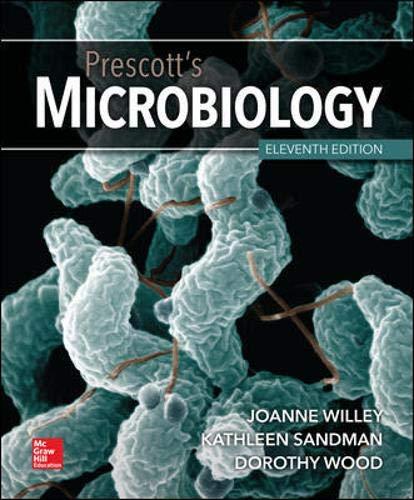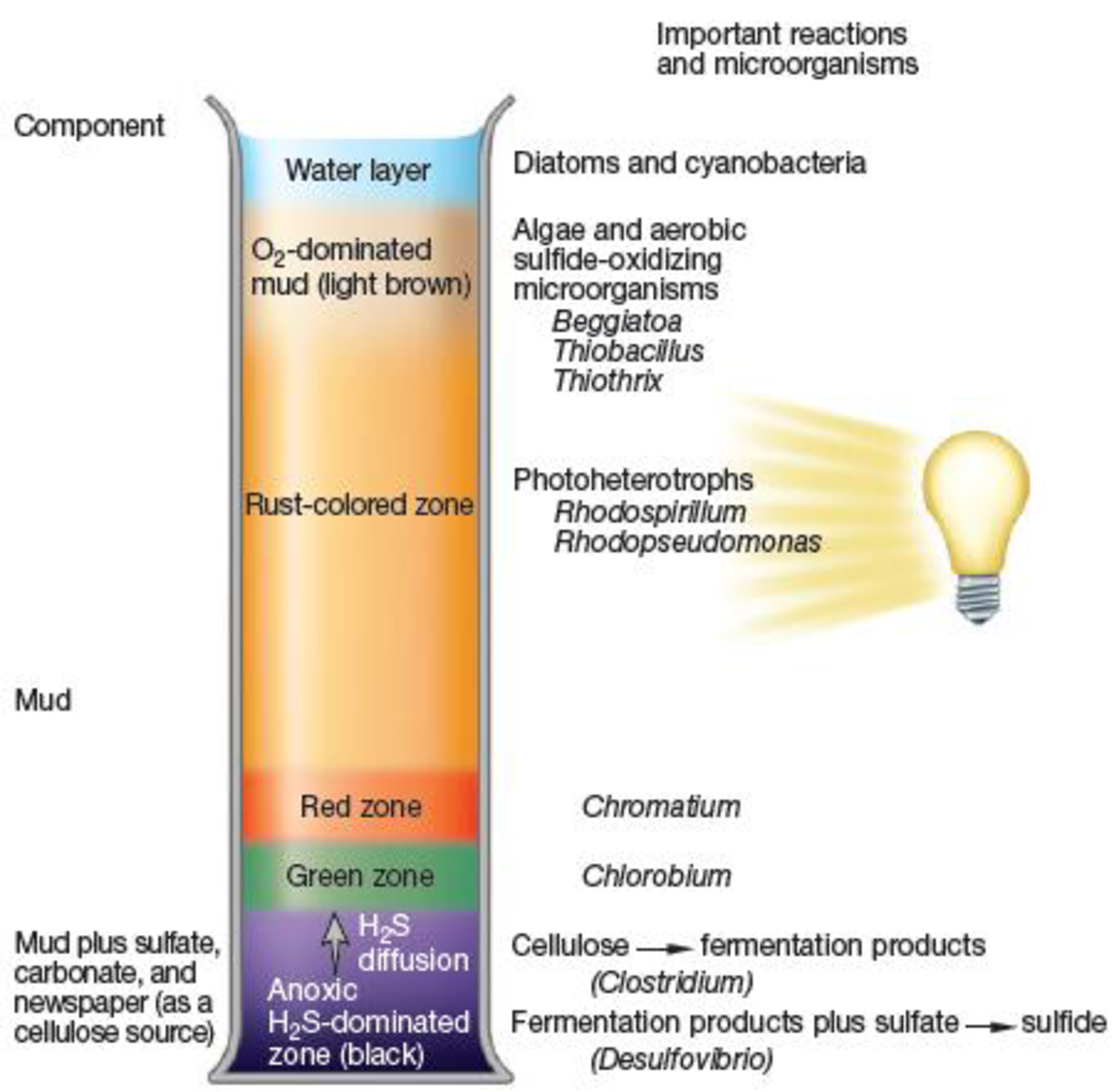
Prescott's Microbiology
11th Edition
ISBN: 9781260211887
Author: WILLEY, Sandman, Wood
Publisher: McGraw Hill
expand_more
expand_more
format_list_bulleted
Concept explainers
Textbook Question
Chapter 30.2, Problem 1MI
How is sulfur cycled between the anoxygenic photosynthetic microbes belonging to the genera Chlorobium and Chromatium, and anaerobic heterotrophic Desulfovibrio spp.?

Figure 30.5 The Winogradsky Column. Microorganisms and nutrients interact over a vertical gradient in these microcosms. Fermentation products and sulfide migrate up from the reduced lower zone, and oxygen penetrates from the surface. This creates conditions similar to those in a lake or salt marsh with nutrient-rich sediments. Light simulates the penetration of sunlight into the anoxic lower region, which stimulates photosynthetic microorganism growth.
Expert Solution & Answer
Trending nowThis is a popular solution!

Students have asked these similar questions
Write the complete redox reactions for the following microbial metabolisms. Give an example of a type of environment where such bacteria may thrive (will there be plentiful O2? Organics-rich sediment? mineral-bearing rock formations etc?)
Oxidation of glucose (C6H12O6) by sulfate (H2SO4) reducers (redox products are CO2 and H2S).
Oxidation of ferrous hydroxide (Fe(OH)2) by iron-oxidizing bacteria in oxygen (O2)-rich environment. Redox products are Fe(OH)3 and H2
Please write all redox reactions correctly and explain! Thanks!
Which of these are valid sulfur cycle pathways?
Sedimentation of thiosulfates
Anoxic emission of sulfides
Atmospheric S6 deposition O
Elemental sulfur oxidation by Thiobacillus
Mineralization of organic and inorganic sulfates O
co2 photochemolithotrophic fixation by anaerobic bacteria
Mineral formation from reduced sulfides
Which of the following statements is false?
A.
Sulfur-oxidizing bacteria may form hydrogen sulfide (H2S) as a product of the oxidation.
B.
Dissimilatory reduction of metals such as Fe3+ to Fe2+ represents anaerobic respiration.
C.
The nitrification reactions carried out by certain bacteria would be considered lithotrophy.
D.
Denitrification reactions would be considered anaerobic respiration.
Chapter 30 Solutions
Prescott's Microbiology
Ch. 30.1 - Prob. 1MICh. 30.1 - What factors influence oxygen solubility? How is...Ch. 30.1 - Describe the buffering system that regulates the...Ch. 30.1 - Prob. 3CCCh. 30.1 - What features of a thermocline make it similar to...Ch. 30.2 - How is sulfur cycled between the anoxygenic...Ch. 30.2 - Prob. 1.1CCCh. 30.2 - Prob. 1.2CCCh. 30.2 - How do heterotrophic microbes contribute to the...Ch. 30.2 - Prob. 3MI
Ch. 30.2 - What is marine snow? Why is it important in CO2...Ch. 30.2 - Prob. 2.2CCCh. 30.2 - Prob. 2.3CCCh. 30.2 - Prob. 2.4CCCh. 30.2 - Prob. 2.5CCCh. 30.2 - Explain what is meant by upside-down microbial...Ch. 30.2 - Prob. 2.7CCCh. 30.3 - Figure 30.15 Nutrient Cycling in Antarctic Lakes...Ch. 30.3 - How does the contribution of benthic autotrophs...Ch. 30.3 - Why does water turbulence play only a minor role...Ch. 30.3 - Why is mixotrophy suited for survival in Antarctic...Ch. 30.3 - What is an oxygen sag curve? What changes in a...Ch. 30.3 - What are point and nonpoint source pollution? Can...Ch. 30.3 - Prob. 4CCCh. 30.3 - Prob. 5CCCh. 30.3 - Why do cyanobacteria often dominate waters that...Ch. 30 - Prob. 1RCCh. 30 - Prob. 2RCCh. 30 - Prob. 3RCCh. 30 - Prob. 4RCCh. 30 - Prob. 5RCCh. 30 - Prob. 6RCCh. 30 - Prob. 7RCCh. 30 - Prob. 8RCCh. 30 - The unicellular cyanobacterium Prochlorococcus sp....Ch. 30 - Prob. 2ALCh. 30 - It is well known that bacterivory (the consumption...Ch. 30 - Prob. 4AL
Knowledge Booster
Learn more about
Need a deep-dive on the concept behind this application? Look no further. Learn more about this topic, biology and related others by exploring similar questions and additional content below.Similar questions
- The anaerobic, chemoautotrophic archaeobacterium Methanococcus jannaschii uses which of the following carbon-fixation pathways to obtain organic carbon from CO2? cell bio the Hill reaction the Wood-Ljungdahl pathway the Calvin cycle oxygenic photosynthesis the Krebs cyclearrow_forward. The anaerobic, chemoautotrophic archaeobacterium Methanococcus jannaschii uses which of the following carbon-fixation pathways to obtain organic carbon from CO2? the Hill reaction the Wood-Ljungdahl pathway the Calvin cycle oxygenic photosynthesis the Krebs cyclearrow_forwardWhich of the following pathways is used to fix inorganic carbon into organic form (like methane), by the anaerobic, chemoautotrophic archaeobacterium Methanococcus jannaschii? the reductive acetyl-CoA pathway the Hill reaction the Krebs cycle the Calvin cycle oxygenic photosynthesisarrow_forward
- So we know that the cloudier the broth is, the more microbes are growing in the broth. How can you use this information to determine if a newly discovered species is a psychrophile, mesophile, or thermophile. Describe a very simple experiment to use the information in the first sentence to determine their temperature preference.arrow_forwardAn unknown microbe is found to be able to photosynthesize, but is also able to fix pyruvate for carbon. What is the best description of this organism? a. photoautotroph b. photochemotroph c. photoheterotroph d. chemoheterotropharrow_forwardThe anaerobic, chemoautotrophic archaeobacterium Methanococcus jannaschii uses which of the following carbon-fixation pathways to obtain organic carbon from CO2? the Hill reaction the reductive acetyl-CoA pathway the Calvin cycle oxygenic photosynthesis the Krebs cyclearrow_forward
- What metabolic class of microorganisms areconsidered primary producers and where are theytypically found in nature?arrow_forwardSoil-based nitrogen-fixing bacteria appear to be highly vulnerable to exposure to UV radiation. Suppose that the ozone level continues to be depleted, what are the long-term effects on the planet?arrow_forwardList environments in which methanogenesis and methane oxidation occurarrow_forward
- Which organisms below take part in the carbon and sulfur cycle? Explain their function in the carbon and sulfur cycle Cellulose degraders Sulfate reducers Sulfur oxidizers Photosynthetic oxygenic organisms Photosynthetic non-oxygenic organismsarrow_forwardFigure 22.19 Which of the following statements about the nitrogen cycle is false? Nitrogen fixing bacteria exist on the root nodules of legumes and in the soil. Denitrifying bacteria convert nitrates (NO3 ) into nitrogen gas (N2). Ammonification is the process by which ammonium ion (NH4+) is released from decomposing organic compounds. Nitrification is the process by which nitrites (NO2-) are converted to ammonium ion (NH4+).arrow_forward1. Which of the following is most likely to result in "immobilization"? A. Assimilation B. Ammonification C. Sulfur oxidation D. Mineralization E . Denitrification 2. What metabolic type in the carbon cycle would most likely benefit from living in the presence of a starch-digesting microbe in an anaerobic environment? A Sugar fermenter: B. Methanogen C. Carbon fixer D. Methane oxidizer E CO reducer 3. Which two of the following choices are the goals of pasteurization? A Kill all spoilage microbes B. Sterilize C. Kill all pathogens D. Reduce spollage microbes E. Reduce pathogen numbersarrow_forward
arrow_back_ios
SEE MORE QUESTIONS
arrow_forward_ios
Recommended textbooks for you
 Biology 2eBiologyISBN:9781947172517Author:Matthew Douglas, Jung Choi, Mary Ann ClarkPublisher:OpenStax
Biology 2eBiologyISBN:9781947172517Author:Matthew Douglas, Jung Choi, Mary Ann ClarkPublisher:OpenStax BiochemistryBiochemistryISBN:9781305577206Author:Reginald H. Garrett, Charles M. GrishamPublisher:Cengage Learning
BiochemistryBiochemistryISBN:9781305577206Author:Reginald H. Garrett, Charles M. GrishamPublisher:Cengage Learning

Biology 2e
Biology
ISBN:9781947172517
Author:Matthew Douglas, Jung Choi, Mary Ann Clark
Publisher:OpenStax

Biochemistry
Biochemistry
ISBN:9781305577206
Author:Reginald H. Garrett, Charles M. Grisham
Publisher:Cengage Learning
Chapter 5 Microbial Metabolism; Author: Heather Davis;https://www.youtube.com/watch?v=wH_HrsfDWZw;License: Standard Youtube License